Users Who Spiked
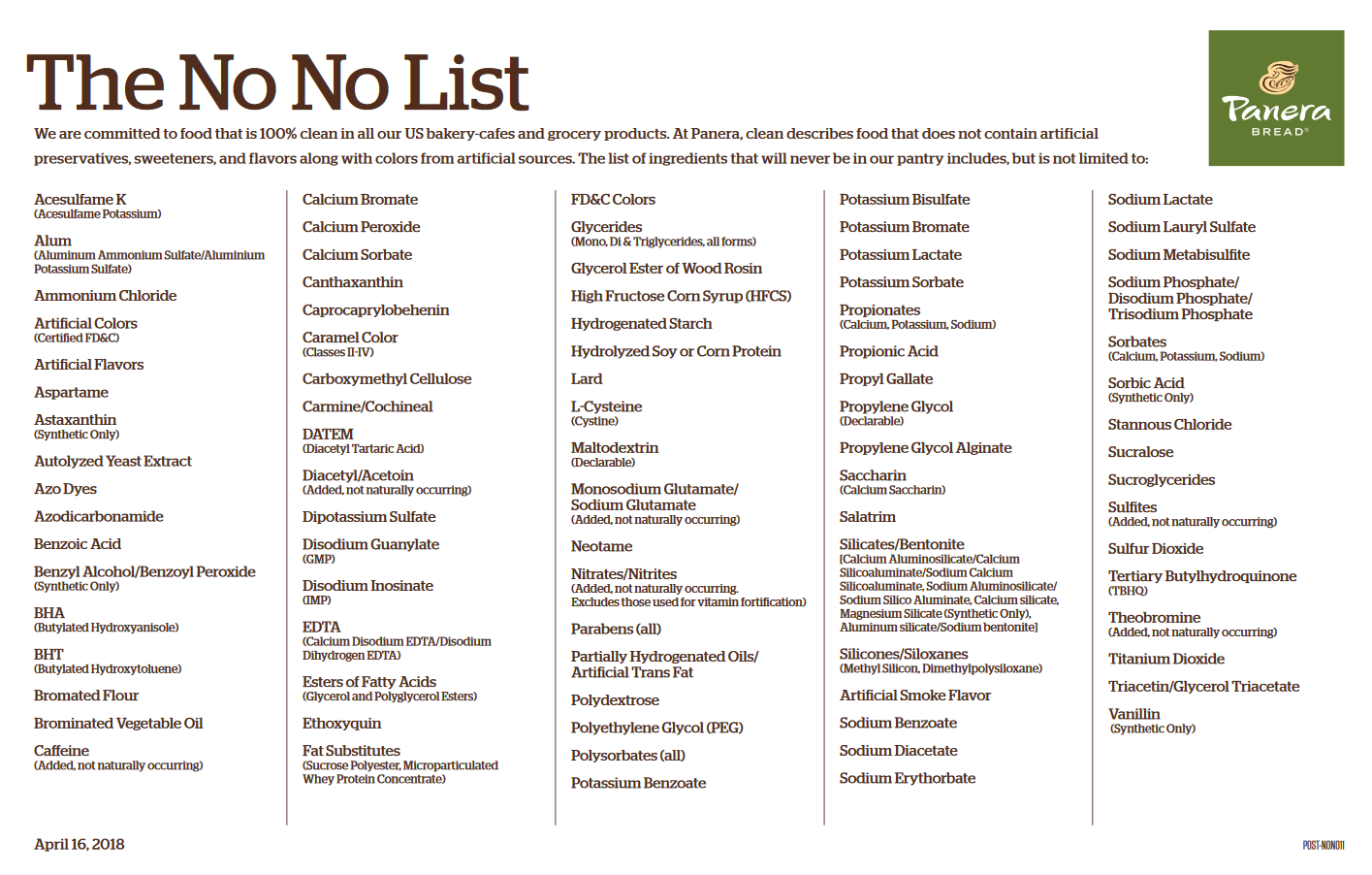
PANERA’S “NO NO LIST” (PART II) … WHAT ARE THESE INGREDIENTS?
Private Notes
Private Notes
Notes
Now that Panera’s Food Policy has been discussed, it is time to discuss the ingredients that have made it on Panera’s “No No List”. This list will be broken down into categories based on ingredient type.

Sweeteners
- Acesulfame K
- Aspartame
- High Fructose Corn Syrup (HFCS)
- Neotame
- Saccharin (calcium saccharin)
- Sucralose
Artificial sweeteners are also called high-intensity sweeteners because they are many times sweeter than sucrose (table sugar). They are typically used in diet sodas and other food products as a low or no calorie sweetener. Products containing these high intensity sweeteners are often labeled as sugar free or diet. The FDA has approved 6 high intensity sweeteners for use: saccharin, aspartame, acesulfame K, sucralose, neotame, and advantame. For aspartame, it should be advised that consumers with phenylketonuria (PKU), a rare genetic disorder, should restrict or avoid consuming aspartame. This is because those with the disorder have a difficult time metabolizing phenylalanine.
High Fructose Corn Syrup (HFCS): is produced from the degradation of corn starch using enzymes. HFCS is primarily used to sweeten processed foods, cereals, baked goods, and beverages (primarily soft drinks). HFCS can contain either 42 or 55 percent fructose, with HFCS 42 being similar in sweetness to sucrose. The FDA recommends limiting consumption of added sugars such as HFCS.
Hydrogenated starch is also known as polyols. These polyols may be composed of sorbitol, maltitol, and other sugar alcohols. These polyols are used to sweeten reduced sugar or reduced calorie products such as chewing gum, desserts, frostings, and other confections.
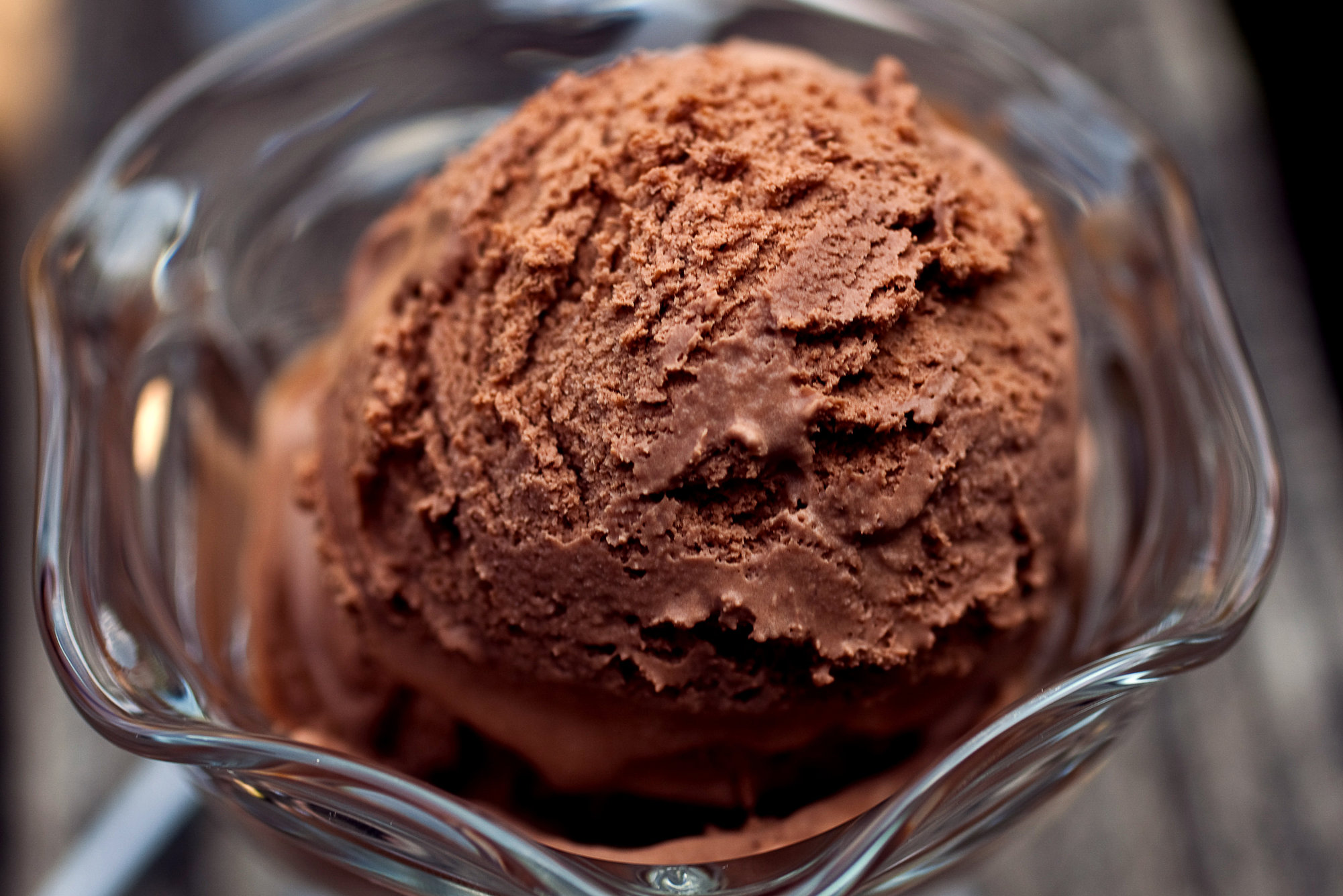
Texturants
- Carboxymethyl cellulose
- Maltodextrin (declarable)
- Polydextrose
- Polyethylene Glycol (PEG)
- Sodium Phosphate/Disodium Phosphate/Trisodium Phosphate
Carboxymethyl cellulose is used in food primarily as a thickener and emulsion stabilizer. Ice cream is the common product that carboxymethyl cellulose is used in to prevent formation of large ice crystals, which is undesirable in ice cream as it would cause a gritty texture (unlike the desired smooth creamy texture).
Maltodextrin is a product from partial hydrolysis of corn starch, potato starch, or rice starch. Maltodextrin is commonly used as a bulking or thickening agent in many food products.
Polydextrose is FDA approved for use as a bulking agent, formulation aid, humectant, and texturizer in foods except meat and poultry, baby food, and infant formula. The FDA also reports that the label of the food must state: “Sensitive individuals may experience a laxative effect from excessive consumption of this product”. The key here is excessive consumption. Most foods are harmful in excessive consumption. Take water for example. According to the American Chemical Society, you would have to drink about 6L of water (if you weighed 165lbs), but at this level, water intoxication would occur. This level of “excessive consumption” varies based on the food product, and it is always important to note tolerance levels.
Polyethylene glycol (PEG) is FDA approved for use as a coater, binder, plasticizing agent, or lubricant in tablets, a flavor improver and bodying agent in non-nutritive sweeteners, and a coating on sodium nitrite to inhibit hygroscopic properties. PEG is not found in milk; the FDA has a tolerance of zero for PEG in milk.
Sodium phosphate/disodium phosphate/trisodium phosphate are all FDA approved for use in multiple food products and is multifunctional.
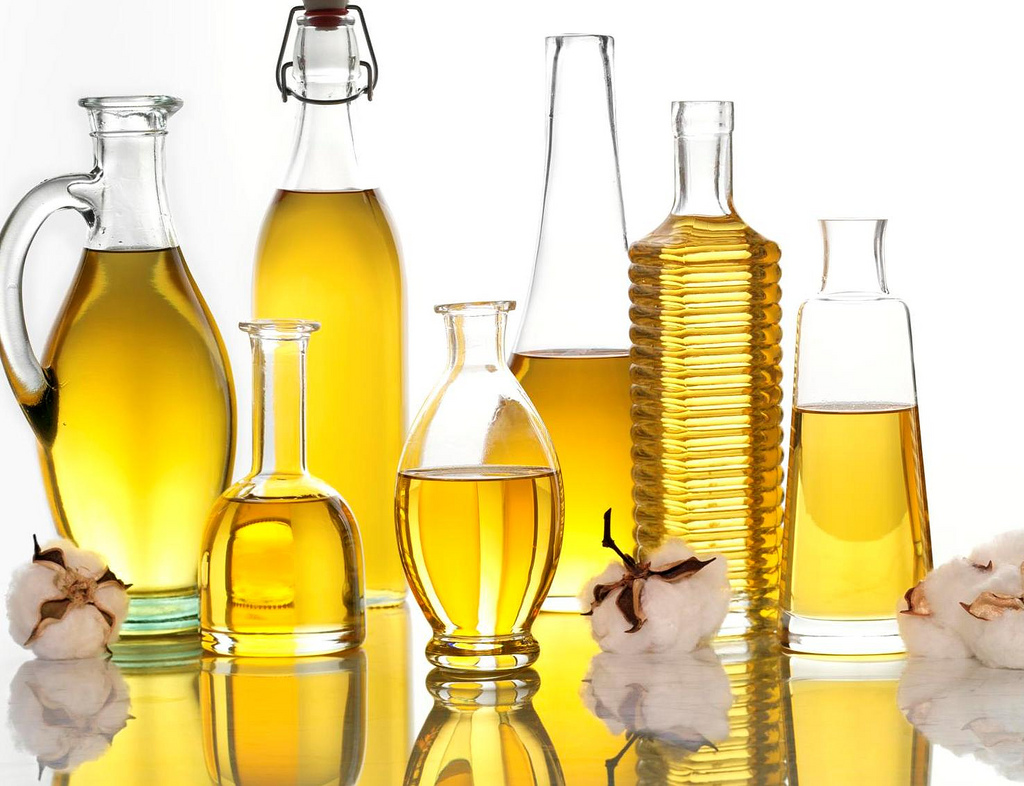
Lipids
- Brominated Vegetable Oil
- Caprocaprylobehenin
- Esters of Fatty Acids (Glycerol and polyglycerol esters)
- Fat Substitutes (Sucrose polyester, microparticulated whey protein concentrate)
- Glycerides (Mono, Di, & Triglycerides, all forms)
- Lard
- Partially Hydrogenated Vegetable Oils/Artificial Trans-Fat
- Salatrim
- Sucroglycerides
(aka Caprenin) (aka Simplesse)
The first blatant confusion is the listing of glycerides (mono, di, & triglycerides). Mono and diglycerides are commonly used as food emulsifiers. Triglycerides (known as triacylglycerols), is where the confusion lies. Panera says “all forms”, but it is unclear as to what they mean. All fats and oils are composed of triacylglycerols. Fats and oils meaning that soybean oil in salad dressing, or the fat cocoa butter in chocolate. Panera clearly has not removed “all forms” of triacylglycerol from their menu. It is also confusing that they then list several triacylglycerols on the No No List as well, including caprocaprylobehenin (aka Caprenin), salatrim, lard, brominated vegetable oil, and partially hydrogenated oils/artificial trans-fat.
Caprenin is a triacylglycerol composed of medium chain fatty acids capric and caprylic acid, and behenic acid (a very long chain fatty acid). Studies have shown that medium chain triacylglycerols are metabolized quickly and tend to not be deposited into adipose tissue. Behenic acid is a very long chain fatty acid that is poorly absorbed by the body.
Salatrim is an abbreviation for “short and long chain acyl triacylglycerol molecule” and is primarily composed of stearic acid (as the long chain fatty acid), and short chain fatty acids such as acetic, propionic, and butyric. Short chain fatty acids are lower in calorie than fatty acids of longer chain length. Stearic acid has also been found to be neutral in raising cholesterol levels versus other long chain saturated fatty acids like palmitic and myristic.
Lard is fat rendered from pig. It contains high amounts of saturated fatty acids and cholesterol. While you do need some saturated fat, excessive consumption of saturated fat and cholesterol increases risk of developing obesity, diabetes, and cardiovascular disease.
Brominated vegetable oil: this additive is used on an interim basis for stabilization of flavoring oils used in fruit-flavored beverages. FDA currently lists its safety status as pending, with a need for more toxicological studies.
Partially hydrogrogenated oils/artificial trans-fats (aka PHOs): PHOs are oils that have been partially hydrogenated in a reaction between a vegetable oil, hydrogen, and a metal catalyst. This process of partial hydrogenation produces trans-fat. Overconsumption of trans-fat has been associated with increased risk of cardiovascular disease, diabetes, obesity, and numerous other diseases detrimental to health. The FDA no longer recognizes PHOs as GRAS, and as of 2018, products can no longer contain trans-fat.
Fat Substitutes (sucrose polyesters, microparticulated whey protein concentrate): sucrose polyesters is also known as Olestra. Microparticulated whey protein concentrate is more commonly known as Simplesse. Panera has a habit in this “No No List” to list some as the full chemical name and some as their trade name, often whichever sounds more scientific or more “toxic”/ harder to pronounce. Panera is also incorrect in defining Olestra and Simplesse as “Fat Substitutes”. In fact, they fall under the category “Fat Replacers”. Fat Replacers function to replace the fat in food products. They chemically resemble fats, proteins, or carbohydrates and can be classified into two groups: fat substitutes and fat mimetics. Fat substitutes, such as Olestra, are lipid or fat-based replacers of the original fat. Enzymatically modified fats/oils also fall under this category. Fat mimetics, such as Simplesse, mimic the physicochemical properties of the fat, but are typically composed of carbohydrates or proteins. Fat mimetics cannot be used for frying because they can bind excessive water, denature (if protein based), or caramelize, at high temperatures. Panera fails to classify these ingredients into the right category, so it is clear this list was made by someone who may have not done enough research.
Esters of Fatty Acids (Glycerol and polyglycerol esters): esters of fatty acids, glycerol, and polyglycerol esters all serve different purposes, and all are FDA approved. Polyglycerol esters are produced from common oils and are used as emulsifiers. Esters (methyl and ethyl) of fatty acids are produced from edible fats and oils and are primarily used in an emulsion for the dehydration of grapes to produce raisins. Glycerol is the backbone of all fats and oils, and is used in many products as a humectant, solvent, sweetener, preservative, and filler.
Sucroglycerides are produced by reacting sucrose with edible fat or oil. They are FDA approved and are primarily used as emulsifiers.
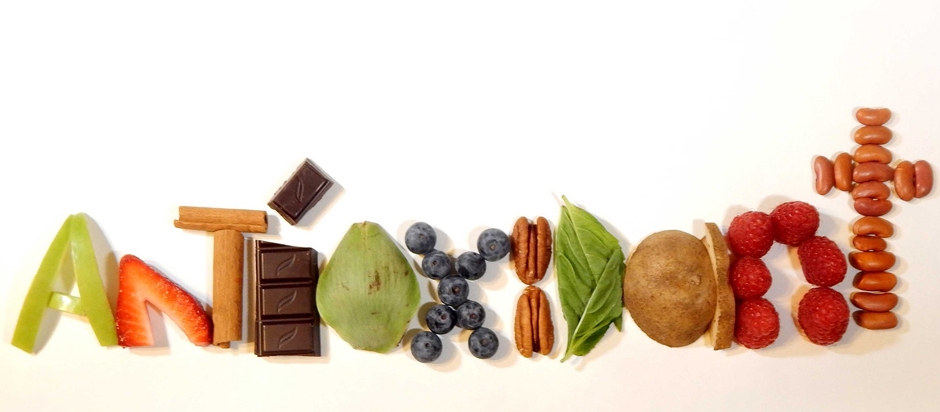
Antioxidants
- BHA (Butylated hydroxyanisole)
- BHT (Butylated hydroxytoluene
- Propyl Gallate
- Sodium Erythorbate
- Stannous chloride
- TBHQ (Tertiary Butylhydroquinone)
All these antioxidants are FDA approved for use as antioxidants (compounds that inhibit oxidation).
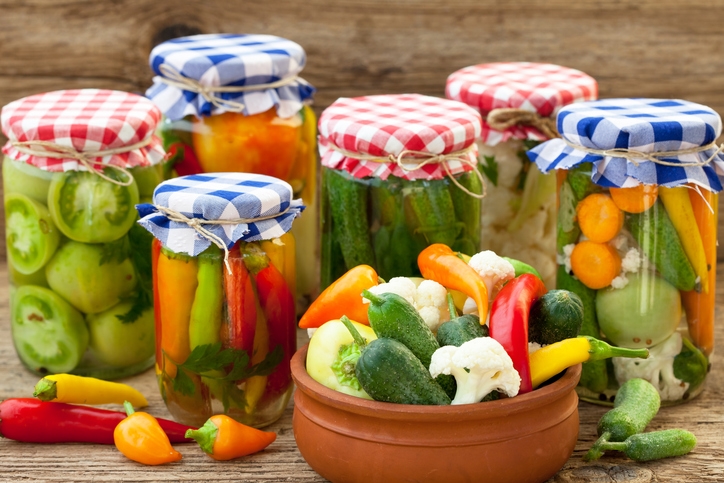
Preservatives
- Alum (Aluminum Ammonium Sulfate/Aluminum Potassium Sulfate)
- Benzoic Acid
- Ethoxyquin
- Calcium Sorbate
- EDTA (Calcium Disodium EDTA/Disodium Dihydrogen EDTA)
- Nitrates/Nitrites (Added, not naturally occurring, excludes those used for vitamin fortification)
- Potassium Benzoate
- Propionates (Calcium, Potassium, Sodium)
- Propionic Acid
- Sodium Benzoate
- Sodium Diacetate
- Sodium Metabisulfite
- Sorbates (calcium, potassium, sodium)
- Sorbic Acid (synthetic only)
- Sulfites (Added, not naturally occurring)
- Sulfur Dioxide
Alum is used primarily in pickling to preserve the fruit/vegetable and add crispness. Alum gives pickles that nice bite when you eat dill pickles. Alum may also be found in baking powder as an acidic ingredient to provide the second phase of leavening (high temperatures).
Benzoic acid is FDA approved for use as an antimicrobial agent and flavoring agent and is only used up to 0.1% in food. Benzoic acid and its salts (sodium benzoate, potassium benzoate) are widely used as food preservatives due to its antimicrobial activity of inhibiting growth of mold, yeast, and some bacteria. Benzoic acid also occurs naturally in cranberries, prunes, plums, cinnamon, ripe cloves, and most berries. Panera fails to state if they are banning benzoic acid that occurs naturally or synthetically or both. Clearly their Cranberry Orange Muffin fails their “No No List” without further clarification as to source.
Sorbic acid is used as a preservative to protect against the growth of fungi and yeast in foods. Calcium sorbate is a salt of sorbic acid and is used mainly in dairy products and rye bread. Potassium sorbate is another salt of sorbic acid that is used as a preservative in cheese, baked goods, syrups, jams, and dehydrated foods such as dried fruit and jerky. Sodium sorbate is another salt of sorbic acid that is used as an antimicrobial agent in foods and drinks to prevent growth of mold, yeast, and fungi. Calcium sorbate, potassium sorbate, sodium sorbate, and sorbic acid meet FDA GRAS status. It is pretty redundant that Panera chooses to list calcium sorbate twice. Having a long list of banned ingredients that rivals lists made by the Food Babe does not win you any awards. It is important for lists such as these to be accurate and well thought out. Panera clearly fails this by listing ingredients more than once on the same list.
Ethoxyquin is FDA approved for use as a color preserver in spices, including chili powder, paprika, and ground chili. It is also approved for use as a preservative in animal feeds to slow oxidation of carotene, xanthophylls, and vitamins A and E, all of which are health beneficial and/or antioxidant compounds.
EDTA (or calcium disodium EDTA) and disodium EDTA are FDA approved preservative that may also promote color, flavor, and/or flavor retention in many food products. EDTA functions as a preservative by being a metal chelator, meaning it chelates metal ions and prevent them from causing degradation of the food product. Lipid oxidation is one concern and metal ions can speed up oxidation.
Nitrates/Nitrites are FDA approved for addition into meat products to help in the curing process by giving meats their distinct color, aroma, and flavor, while also helping preserve the meat. The FDA has set a maximum level for addition of nitrates/nitrites in food products due to the concern that these are potential carcinogens when over consumed.
Polysorbates are emulsifiers derived from ethoxylated sorbitan esterified with fatty acids. These polysorbates have different numbers (ex: 20, 80) depending on how many fatty acids are esterified. They have a wide range of applications, and help stabilize emulsions that can be either w/o or o/w.
Propionates (Calcium, potassium, and sodium) and propionic acid are used as antimicrobial agents.
Sodium diacetate is used as an antimicrobial agent and pH control agent in baked goods, candy, gravies, sauces, snack foods, and soups.
Sodium metabisulfite is FDA approved for use as a preservative except in foods such as meat, foods that are a recognized source of vitamin B1, and raw fruits and vegetables. Sulfites and sulfur dioxide are FDA approved for use as an antioxidant and antibacterial agent, particularly in wine. Some may be allergic to sulfites, so FDA requires it to be listed.
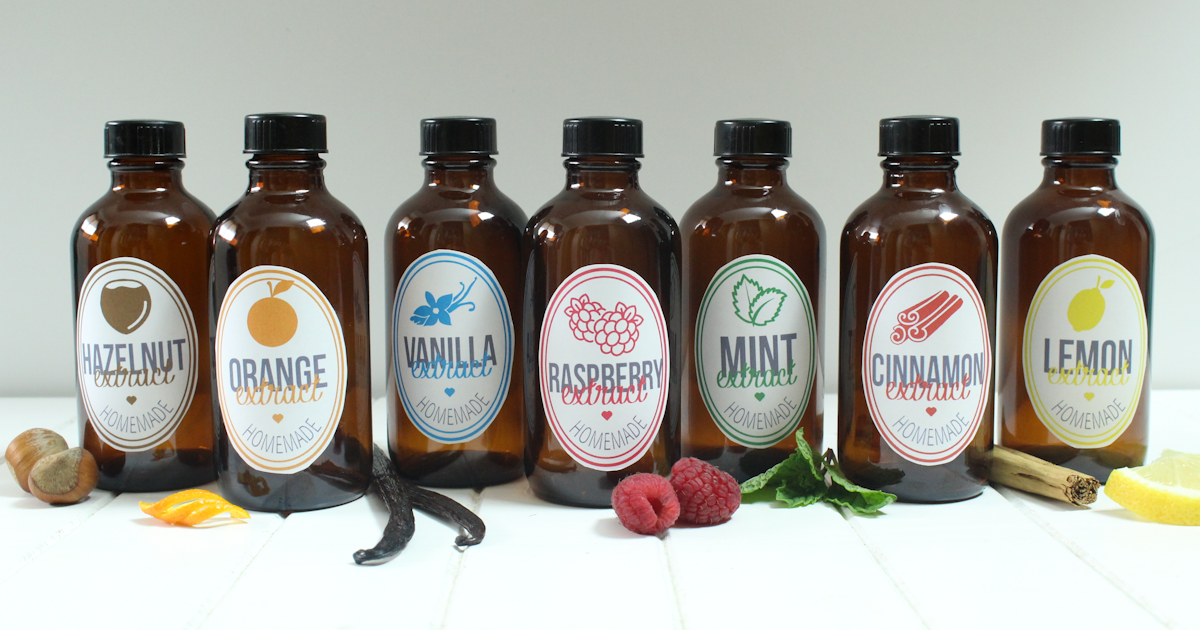
Flavors/Flavoring Agents
- Artificial Flavors
- Autolyzed Yeast Extract
- Diacetyl/Acetoin
- Dipotassium Sulfate
- Disodium Guanylate (GMP)
- Disodium Inosinate (IMP)
- Hydrolyzed soy or corn protein
- Monosodium Glutamate/Sodium Glutamate (Added, not naturally occurring)
- Parabens (all)
- Potassium Lactate
- Artificial Smoke Flavor
- Theobromine (Added, not naturally occurring)
- Vanillin (Synthetic only)
Monosodium glutamate (MSG) is a sodium salt of the amino acid glutamic acid. We perceive MSG to have a meaty, umami flavor, much like your steak or beef stock. Glutamic acid is one of the 20 amino acids and is found naturally present in our body and in many foods. For example, MSG occurs naturally in tomatoes, cheese, autolyzed yeast extract, and hydrolyzed vegetable protein (aka hydrolyzed soy or corn protein). So, the fact that Panera bans autolyzed yeast extract and hydrolyzed soy or corn protein, is kind of a conundrum. These foods contain naturally occurring MSG. Why are they banned? Added MSG typically comes from fermentation of starch, sugar beets, sugar cane, or molasses. Additionally, Panera has added disodium guanylate (GMP) and disodium inosinate (IMP) to their No No List. GMP and IMP are FDA approved for use as flavor enhancers, particularly their ability to enhance the perception of umami, or meaty flavors.
Chemically, glutamate from added MSG and naturally occurring MSG are the same and are metabolized in our body the same way. Food labels must label added MSG but do not have to label naturally occurring MSG. The FDA has deemed MSG safe, and an independent study from the Federation of American Societies for Experimental Biology (FASEB) concluded that there were minimal effects (short term mild headache/numbness/flushing/tingling/palpitations/drowsiness) from consuming over 3 grams of MSG without food. To put this into perspective, you would need to consume about 10 beef bouillon/stock cubes by themselves without any food. This was from a study that determined the average MSG concentration is about 10 g/kg, and each cube is about 5g total weight.
MSG Levels: https://www.tandfonline.com/doi/abs/10.1080/19393210.2014.991355
MSG FDA: https://www.fda.gov/food/ingredientspackaginglabeling/foodadditivesingredients/ucm328728.htm
Diacetyl and acetoin are two compounds found often in microwaved popcorn to give its characteristic buttery flavor. Diacetyl occurs naturally in butter, cheese, and fruits, and is FDA approved as a flavor ingredient. While diacetyl is safe to consume, it may be harmful to breathe in when working with large quantities required for food production. The National Institute for Occupational Safety and Health (NIOSH) published a comprehensive document on safe exposure levels for workers to help reduce risk of harming lungs.
Diacetyl https://www.cdc.gov/niosh/topics/flavorings/exposure.html
Dipotassium sulfate, also more correctly known as potassium sulfate, is an FDA approved flavoring agent, typically used in flavoring of beverages, particularly carbonated sodas. Potassium sulfate is also used in water purification, by aiding in removal of unwanted particles. It is unclear if Panera would even need to remove this ingredient from their products. Panera should be clear about which items they removed and which items were never present in their food in the first place.
Parabens are FDA approved for use in food and food packaging as antimicrobial agents to help prevent food spoilage. Any parabens that you consume are quickly excreted. The importance of antimicrobials such as parabens are to reduce harmful microorganisms so that the chance for people getting sick from pathogenic microorganisms is reduced.
Potassium Lactate is FDA approved for use as a flavor enhancer, humectant, and pH control agent.
Theobromine is a bitter compound in the same family as caffeine, found in the cacao plant. It is found in chocolate and other foods such as tea leaves, and kola nut. Theobromine has been found to be toxic (at certain levels) to dogs, hence why you should not feed dogs chocolate. Theobromine may be added to bread, cereal, and sports drinks, but mostly it is found naturally in chocolate.
Potassium benzoate helps preserve foods by inhibiting the growth of mold, yeast, and bacteria.
Artificial smoke flavor is FDA approved and gives products a nice smoky flavor
Vanillin (synthetic only) is the primary component of the extract from the vanilla bean. Most foods are flavored with vanillin because it is more cost effective and more easily available than vanilla bean.
Artificial Flavors are regulated by the FDA and depend on the compound as to whether it is FDA approved or not. These artificial flavors are often made by combining chemicals to produce a product that smells and more importantly tastes like a natural flavoring. Most artificial flavors are a cheaper alternative that is more readily available.
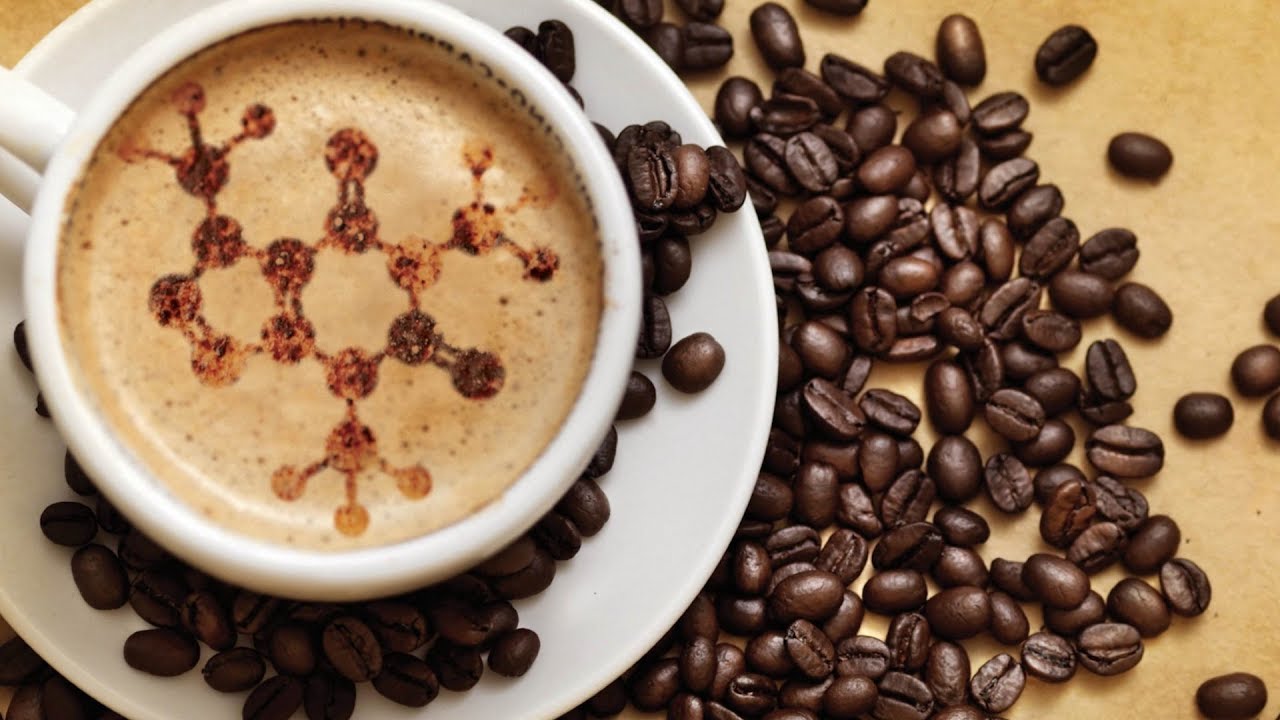
Caffeine (Added, not naturally occurring)
Caffeine is naturally occurring in coffee beans, tea leaves, kola nuts, yerba mate leaves, cacao beans, and others. There is ample caffeine available from decaffeination of coffee beans and tea leaves, though there are manufacturers that produce caffeine synthetically (chemically there is no difference). The decaffeination process extracts caffeine by water extraction or supercritical carbon dioxide extraction. Solvent extraction is another method but is increasingly used less. After extraction, producers isolate and refine the caffeine, leaving a white and odorless powder. The original beans or leaves can now be marketed as decaf. The caffeine that is extracted is sold for use in food products. A common product that requires added caffeine is soda. It is unclear what products, if any, Panera had that contained added caffeine before this “No No List”. However, Panera continues to sell soda, so it is untrue to say that no products sold at their cafes contain added caffeine. What Panera is lacking is educating consumers on the ingredients on their “No No List”. They should explain what ingredients on this list were removed from their products and what ingredients they added to this list just to say that its not in their products. If an ingredient was not even in Panera products in the first place, it should be explained, otherwise the claim is misleading.
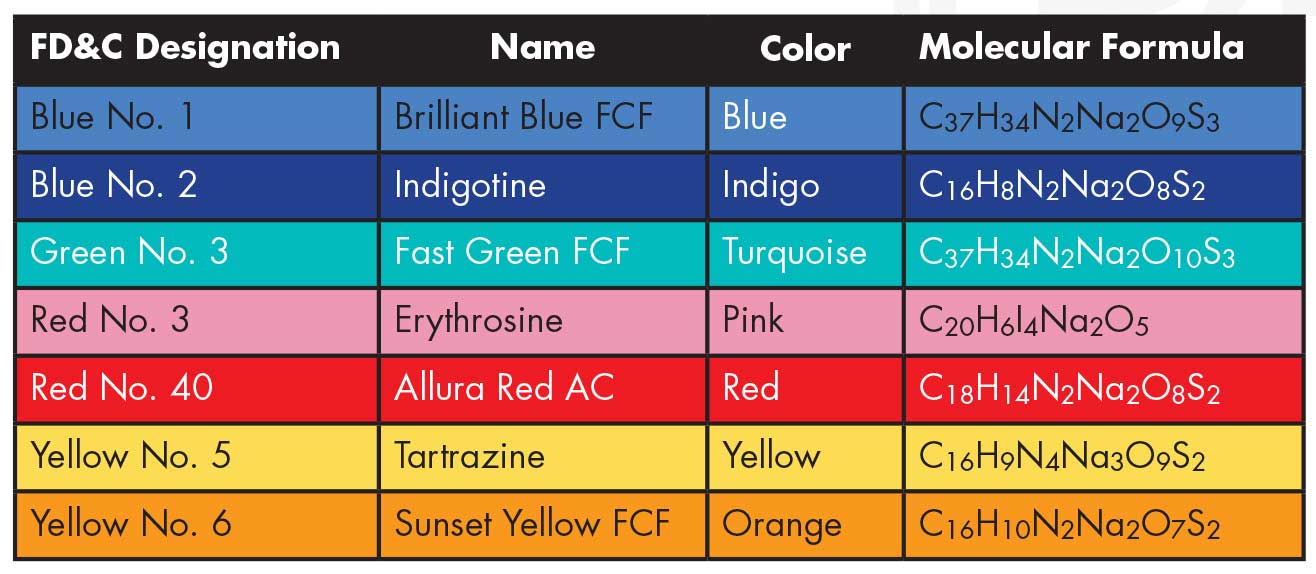
Colors/Whitening Agents
- Artificial Colors (Certified FD&C)
- Astaxanthin (Synthetic only)
- Azo Dyes
- Benzyl Alcohol/Benzoyl Peroxide (synthetic only)
- Canthaxanthin
- Caramel Color (Classes II-IV)
- Carmine/Cochineal
- FD&C Colors
- Titanium Dioxide
Astaxanthin is a lipid soluble red pigment, part of the carotenoid family and found naturally in many seafoods (shrimp, crab, lobster, crayfish). The synthetic form of astaxanthin is primarily used (and approved for use by the FDA (CFR Title 21 Part 73.35)) as a color additive in fish feed to improve the flesh color of the seafoods such as salmon. Cantaxanthin also falls under FDA approval for use in broiler chicken feed to improve the yellow color of the broiler chicken skin and the red color of salmon.
The FDA has approved the use of benzoyl peroxide as a bleaching agent in flour, whey processing, and milk (for Italian cheese making). During cheese making, benzoyl peroxide is almost totally converted to benzoic acid. What is interesting is that Panera grouped benzyl alcohol and benzoyl peroxide together. Chemically these are two different structures and are not the same compound. The FDA has approved benzoyl alcohol as a flavoring agent. Benzoyl alcohol occurs naturally in some edible fruits, and green and black tea. It is commonly used to flavor chewing gums and beverages. During digestion, benzyl alcohol is converted to benzoic acid.
Titanium Dioxide is FDA approved for use as a coloring agent, particularly as a whitener.
Caramel Color is FDA approved and classified into 4 different classes: I-IV. Class I is plain caramel colors, class II is caustic sulfite caramel colors, class III is ammonia caramel colors, and class IV is sulfite ammonia caramel colors. All caramel colors vary in ionic charge for different applications. All classes are GRAS, though some are concerned about the compound 4-MeI which forms during production of Class III and Class IV Caramel colors. However, there is no report from any health regulatory agency that has said 4-MeI is a human carcinogen.
Carmine/Cochineal is an FDA approved color additive from the cochineal beetle. It may sound gross, eating something made from a beetle, however the color is processed to ensure food safety.
FD&C Colors (aka Artificial Colors (Certified FD&C), as Panera listed both) are FDA approved for use in foods. They do not cause any toxicological effects. FD&C colors have been found to not be linked to hyperactivity in children and does not cause ADHD. Finding natural alternatives to FD&C colors are often challenging as most natural sources impart other flavors in the food or the colorant is not very heat stable. Azo dyes (such as tartrazine) are artificial colors, most commonly used to color yellow/red dyes.
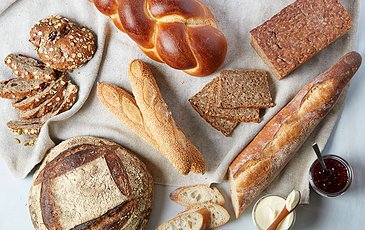
Conditioners/Leavening Agents
- Ammonium chloride
- Azodicarbonamide
- Bromated Flour
- Calcium Bromate
- Calcium Peroxide
- L-Cysteine (Cystine)
- Potassium Bromate
- Propylene Glycol
- Propylene Glycol Alginate
Dough conditioners are added to dough during breadmaking to strengthen the gluten network, or to improve the quality in some way. Dough conditioners consist of pH regulators, enzymes, emulsifiers, and others. Ammonium chloride works to condition dough as a yeast nutrient and an acidifier.
Azodicarbonamide is FDA approved as a whitening agent and dough conditioner in bread making. During bread making, azodicarbonamide does break down to form other chemicals, including semicarbazide. FDA found that there was no increase incident of tumors overall for either rat gender (though they did find a slight increase for female mice, but not male mice). Azodicarbonamide is not required for breadmaking, and there are other alternatives.
Potassium bromate or calcium bromate, is added to flour to produce bromated flour. The FDA states that potassium bromate should only be added in 50 ppm and only added to flours if the baking qualities are improved after such edition. 50 ppm (parts per million) is such a small quantity. Additionally, the baking process almost entirely removes it. Potassium bromate is also approved for use in the malting of barley to produce “Brewer’s” or “Distiller’s” Malt for use in production of fermented malt beverages or distilled spirits only.
Calcium peroxide is widely used (and FDA approved) in baking to strengthen dough for better texture, moisture, and yield.
L-Cysteine is FDA approved for use in flour or dough as a dough strengthener in yeast-leavened baked goods/mixes. Cystine is the oxidized dimer form of cysteine. Both are found in products such as meat, eggs, dairy products, human skin, and human hair.
Potassium bisulfate is FDA approved (GRAS) for use in cake mixes to help control pH and as a leavening agent. It is also generally used in other food products as a pH control agent and processing aid.
Propylene glycol and propylene glycol alginate are FDA approved for use as anticaking agents, dough strengtheners, processing aids, thickeners, stabilizers, and texturizers.
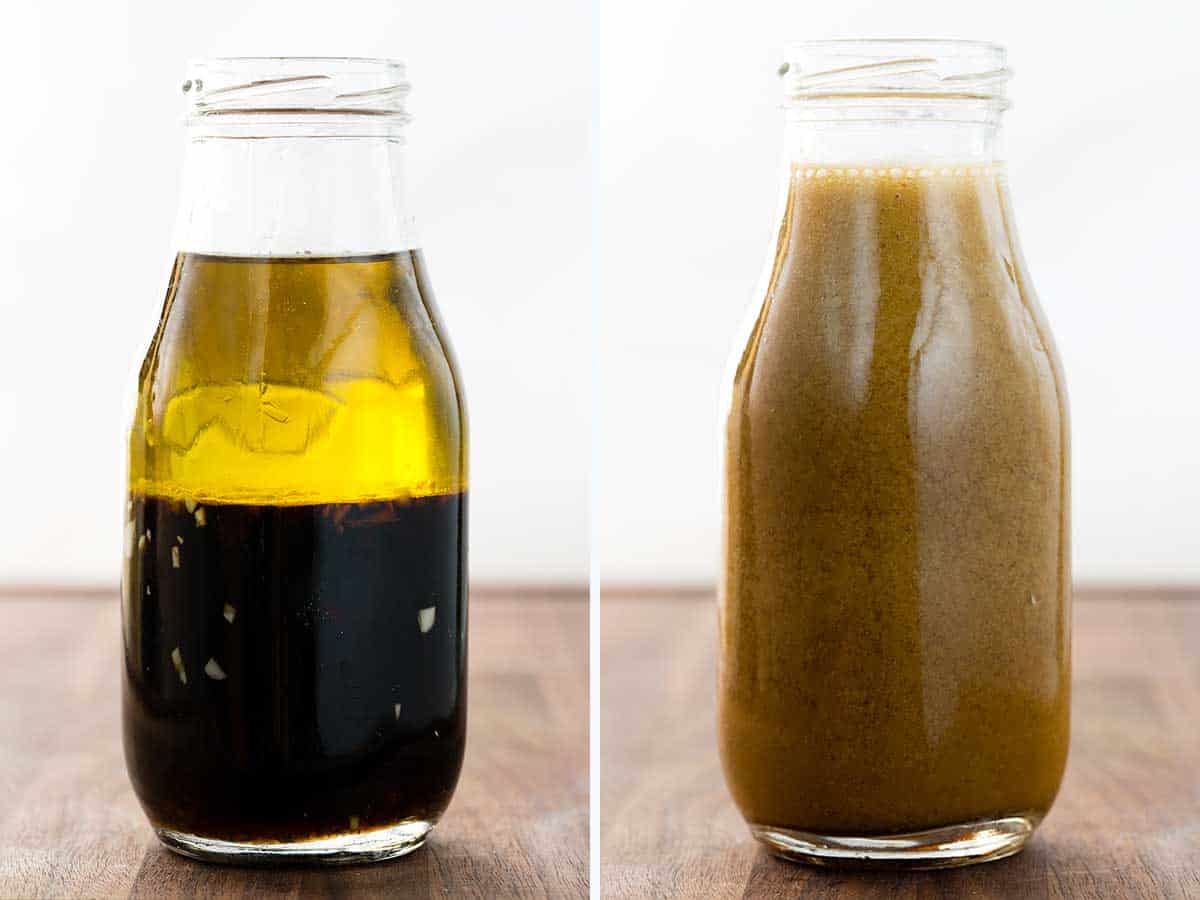
Emulsifiers
- DATEM (diacetyl tartaric acid)
- Polysorbates (all)
- Sodium Lactate
- Sodium lauryl sulfate
- Triacetin/Glycerol Triacetate
DATEM actually stands for diacetyl tartaric esters of monoglycerides. The structure of DATEM is based on a glycerol backbone (much like triacylglycerols a.k.a. what fats and oils are composed of) with diacetyl tartaric acid and some fatty acids (1 or 2) esterified to the glycerol. The glycerol, diacetyl tartaric acid, and the fatty acids are all derived from edible sources. DATEM is commonly used as an emulsifier or flavoring agent. It is used in baked goods, beverages, confections, dairy products, sauces and dips, and fats and oils. In baking, DATEM strengthens the gluten network in dough, allowing for the desirable texture in products such as crusty breads or biscuits. DATEM is also used as an anti-spattering agent for cooking margarines. Anti-spattering agents may help protect those that are cooking or frying from getting hot oil on them.
Sodium lactate is FDA approved for use as an emulsifier, flavor enhancer, flavoring agent, humectant, and pH control agent.
Sodium lauryl sulfate is FDA approved and usually used as an emulsifier or thickener. It is commonly used in or with egg whites, as a whipping agent in the preparation of marshmallows, and a wetting agent that aids in the partitioning of high and low melting fractions of a crude fat or oil during refinement.
Triacetin/glycerol triacetate is FDA approved and widely used as a food emulsifier.
Glycerol ester of wood rosin is FDA approved for use in adjusting the density of citrus oils suspended in beverages and cannot exceed 100ppm in a finished beverage.

Anti-foaming Agents
- Silicones/Siloxanes (Methyl Silicon, Dimethylpolysiloxane)
Dimethylpolysiloxane (food grade, not the kind found in silly putty) is an anti-foaming agent. The World Health Organization (WHO) reported no significant toxicological effects of dimethylpolysiloxane and that it is mostly secreted from the body This data was based on numerous studies, which can be found here. Its use in oil protects workers working the fryers from getting splattered with hot oil. It is similar in function to DATEM, so the fact Panera is banning both, there is concern over the safety of their workers. What are they using to replace these helpful ingredients? There are alternatives, such as nitrogen, salt, calcium chloride, phosphates, or emulsifiers such as egg yolk and lecithin, however these ingredients range in effectiveness as anti-spattering agents.
Silicon is a naturally occurring compound in many foods such as unrefined grains, root vegetables, meat, milk, and beer. Silicone is the synthetic version of that. Silicone is used in cookware, such as the spatulas shown above. It is unclear what Panera means by methyl silicon, as methyl silicone is what is found in foods such as cooking sprays as anti-foaming agents.
Silicates are used as anticaking agents. Bentonite is used to remove impurities from fats/oils and as a clarifying agent in products such as beer, wine, mineral water, sugar, and honey. All the other long list of ingredients underneath silicates/bentonite are all different forms of silicate. Panera should have listed silicates and bentonite separate.
Conclusion
Panera has a lot to improve on with their No No List. They say they are transparent with their customers, but that is far from the truth. It is very hard to find any information from Panera Bread notifying the consumer what these ingredients are and if the ingredient was in their food in the first place. Recently, I contacted Panera’s customer service to ask questions about the No No List ingredients. They could not provide me with any information. While I do not expect the customer service reps to understand what these ingredients are, they should at least be provided with a list that says what all these ingredients are. It may be a problem with their entire Food Policy and is something Panera’s Director (who has an MBA and BA in Biology and Psychology, no Food Science degree) should address. This “No No List” gives a negative perception to ingredients on this list. Instead of being transparent, Panera is creating more fear and confusion than ever. Bottom line: just because an ingredient sounds confusing or not super appetizing, does not mean it is unsafe.

Let me know your thoughts of Panera’s “No No List” in the comments. I am open to discuss any of the above ingredients, their safety, use, or other questions that have arisen from reading this article.

















